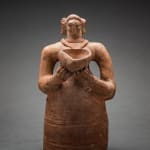Indus Valley Terracotta Figurine of a Standing Woman, 2800 BCE - 2000 BCE
Terracotta
height 23.5 cm
height 9 1/4 in
height 9 1/4 in
LO.884
Further images
Impressing terracotta cylindrical hollow figurine of a standing woman, her large wheel-thrown skirt with incised concentric horizontal lines, both upper arms attached to the body, the lower arms raised at...
Impressing terracotta cylindrical hollow figurine of a standing woman, her large wheel-thrown skirt with incised concentric horizontal lines, both upper arms attached to the body, the lower arms raised at an angle, her oversized hands holding a large bowl. The small face carefully delineated, her hair tied up at the sides into two pony tails, swept back on the front.
The Indus Civilization is still enigmatic: an ancient civilization with a yet-to be deciphered writing system, a mysterious monumental architecture, no monumental art, a puzzling decline, and little evidence of the identity of its direct descendants. In a civilization extending over an area so vast, one would expect to find monumental art and/or architectural symbols of power displaying the names of the powerful. Instead, the emphasis is placed on small, elegant art and sophisticated craft technology.
Three-dimensional representations of living beings in the Harappan world are confined to a few stone and bronze statues and some small objects crafted in faience, stone, and other materials - with one important exception. Ranging variously in size, the anthropomorphic and animal terracotta figurines the Indus Civilization sites depict life as seen by the Harappan people in the Bronze Age.
Terracotta figurines have long been considered toys, often without question. The earliest anthropomorphic figurines from Harappa date back to the Early Harappan (Ravi Phase, Period 1, and Kot Diji Phase, Period 2) levels. Among these are stylized seated female figurines with exaggerated buttocks and thighs and joined legs extended in front.
However, large terracotta figurines thrown on the wheel such as this one, mostly seem to have come from the valley of Bajaur in Pakistan, where a distinctive style of semi-realistic anthropomorphic figurines was allegedly produced during the early 3rd millennium BCE. Incredibly enough, the extraordinary blend of realism -imbued in the face of our lady-, and surrealism -of her large hands and exaggerated torso- would not feel out of place in a contemporary setting, thus transcending the boundaries of time and space.
The Indus Civilization is still enigmatic: an ancient civilization with a yet-to be deciphered writing system, a mysterious monumental architecture, no monumental art, a puzzling decline, and little evidence of the identity of its direct descendants. In a civilization extending over an area so vast, one would expect to find monumental art and/or architectural symbols of power displaying the names of the powerful. Instead, the emphasis is placed on small, elegant art and sophisticated craft technology.
Three-dimensional representations of living beings in the Harappan world are confined to a few stone and bronze statues and some small objects crafted in faience, stone, and other materials - with one important exception. Ranging variously in size, the anthropomorphic and animal terracotta figurines the Indus Civilization sites depict life as seen by the Harappan people in the Bronze Age.
Terracotta figurines have long been considered toys, often without question. The earliest anthropomorphic figurines from Harappa date back to the Early Harappan (Ravi Phase, Period 1, and Kot Diji Phase, Period 2) levels. Among these are stylized seated female figurines with exaggerated buttocks and thighs and joined legs extended in front.
However, large terracotta figurines thrown on the wheel such as this one, mostly seem to have come from the valley of Bajaur in Pakistan, where a distinctive style of semi-realistic anthropomorphic figurines was allegedly produced during the early 3rd millennium BCE. Incredibly enough, the extraordinary blend of realism -imbued in the face of our lady-, and surrealism -of her large hands and exaggerated torso- would not feel out of place in a contemporary setting, thus transcending the boundaries of time and space.





